《数据库系统概念 Database System Concepts》原书教学资源(第六版,PPT课件讲稿,英文版)Chapter 26 Advanced Transaction Processing
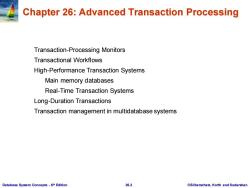
Chapter 26:Advanced Transaction Processing Transaction-Processing Monitors Transactional Workflows High-Performance Transaction Systems Main memory databases Real-Time Transaction Systems Long-Duration Transactions Transaction management in multidatabase systems Database System Concepts-6th Edition 26.2 @Silberschatz,Korth and Sudarshan
Database System Concepts - 6 26.2 ©Silberschatz, Korth and Sudarshan th Edition Chapter 26: Advanced Transaction Processing Transaction-Processing Monitors Transactional Workflows High-Performance Transaction Systems Main memory databases Real-Time Transaction Systems Long-Duration Transactions Transaction management in multidatabase systems
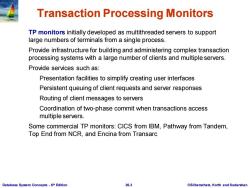
Transaction Processing Monitors TP monitors initially developed as multithreaded servers to support large numbers of terminals from a single process. Provide infrastructure for building and administering complex transaction processing systems with a large number of clients and multiple servers. Provide services such as: Presentation facilities to simplify creating user interfaces Persistent queuing of client requests and server responses Routing of client messages to servers Coordination of two-phase commit when transactions access multiple servers. Some commercial TP monitors:CICS from IBM,Pathway from Tandem, Top End from NCR,and Encina from Transarc Database System Concepts-6th Edition 26.3 @Silberschatz,Korth and Sudarshan
Database System Concepts - 6 26.3 ©Silberschatz, Korth and Sudarshan th Edition Transaction Processing Monitors TP monitors initially developed as multithreaded servers to support large numbers of terminals from a single process. Provide infrastructure for building and administering complex transaction processing systems with a large number of clients and multiple servers. Provide services such as: Presentation facilities to simplify creating user interfaces Persistent queuing of client requests and server responses Routing of client messages to servers Coordination of two-phase commit when transactions access multiple servers. Some commercial TP monitors: CICS from IBM, Pathway from Tandem, Top End from NCR, and Encina from Transarc

TP Monitor Architectures remote server files remote server files clients clients (a)Process-per-client model (b)Single-server model monitor remote router servers files remote routers servers files clients clients (c)Many-server,single-router model (d)Many-server,many-router model Database System Concepts-6th Edition 26.4 @Silberschatz,Korth and Sudarshan
Database System Concepts - 6 26.4 ©Silberschatz, Korth and Sudarshan th Edition TP Monitor Architectures

TP Monitor Architectures (Cont.) Process per client model -instead of individual login session per terminal,server process communicates with the terminal,handles authentication,and executes actions. Memory requirements are high Multitasking-high CPU overhead for context switching between processes Single process model -all remote terminals connect to a single server process. Used in client-server environments Server process is multi-threaded;low cost for thread switching No protection between applications Not suited for parallel or distributed databases Database System Concepts-6th Edition 26.5 @Silberschatz,Korth and Sudarshan
Database System Concepts - 6 26.5 ©Silberschatz, Korth and Sudarshan th Edition TP Monitor Architectures (Cont.) Process per client model - instead of individual login session per terminal, server process communicates with the terminal, handles authentication, and executes actions. Memory requirements are high Multitasking- high CPU overhead for context switching between processes Single process model - all remote terminals connect to a single server process. Used in client-server environments Server process is multi-threaded; low cost for thread switching No protection between applications Not suited for parallel or distributed databases
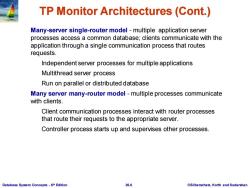
TP Monitor Architectures (Cont.) Many-server single-router model-multiple application server processes access a common database;clients communicate with the application through a single communication process that routes requests. Independent server processes for multiple applications Multithread server process Run on parallel or distributed database Many server many-router model-multiple processes communicate with clients. Client communication processes interact with router processes that route their requests to the appropriate server. Controller process starts up and supervises other processes. Database System Concepts-6th Edition 26.6 @Silberschatz,Korth and Sudarshan
Database System Concepts - 6 26.6 ©Silberschatz, Korth and Sudarshan th Edition TP Monitor Architectures (Cont.) Many-server single-router model - multiple application server processes access a common database; clients communicate with the application through a single communication process that routes requests. Independent server processes for multiple applications Multithread server process Run on parallel or distributed database Many server many-router model - multiple processes communicate with clients. Client communication processes interact with router processes that route their requests to the appropriate server. Controller process starts up and supervises other processes
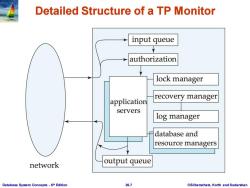
Detailed Structure of a TP Monitor input queue authorization lock manager application recovery manager servers log manager database and resource managers network output queue Database System Concepts-6th Edition 26.7 @Silberschatz,Korth and Sudarshan
Database System Concepts - 6 26.7 ©Silberschatz, Korth and Sudarshan th Edition Detailed Structure of a TP Monitor
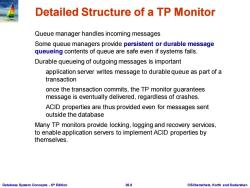
Detailed Structure of a TP Monitor Queue manager handles incoming messages Some queue managers provide persistent or durable message queueing contents of queue are safe even if systems fails. Durable queueing of outgoing messages is important application server writes message to durable queue as part of a transaction once the transaction commits,the TP monitor guarantees message is eventually delivered,regardless of crashes. ACID properties are thus provided even for messages sent outside the database Many TP monitors provide locking,logging and recovery services, to enable application servers to implement ACID properties by themselves. Database System Concepts-6th Edition 26.8 @Silberschatz,Korth and Sudarshan
Database System Concepts - 6 26.8 ©Silberschatz, Korth and Sudarshan th Edition Detailed Structure of a TP Monitor Queue manager handles incoming messages Some queue managers provide persistent or durable message queueing contents of queue are safe even if systems fails. Durable queueing of outgoing messages is important application server writes message to durable queue as part of a transaction once the transaction commits, the TP monitor guarantees message is eventually delivered, regardless of crashes. ACID properties are thus provided even for messages sent outside the database Many TP monitors provide locking, logging and recovery services, to enable application servers to implement ACID properties by themselves

Application Coordination Using TP Monitors A TP monitor treats each subsystem as a resource manager that provides transactional access to some set of resources. The interface between the TP monitor and the resource manager is defined by a set of transaction primitives The resource manager interface is defined by the X/Open Distributed Transaction Processing standard. TP monitor systems provide a transactional remote procedure call (transactional RPC)interface to their service Transactional RPC provides calls to enclose a series of RPC calls within a transaction. Updates performed by an RPC are carried out within the scope of the transaction,and can be rolled back if there is any failure. Database System Concepts-6th Edition 26.9 @Silberschatz,Korth and Sudarshan
Database System Concepts - 6 26.9 ©Silberschatz, Korth and Sudarshan th Edition Application Coordination Using TP Monitors A TP monitor treats each subsystem as a resource manager that provides transactional access to some set of resources. The interface between the TP monitor and the resource manager is defined by a set of transaction primitives The resource manager interface is defined by the X/Open Distributed Transaction Processing standard. TP monitor systems provide a transactional remote procedure call (transactional RPC) interface to their service Transactional RPC provides calls to enclose a series of RPC calls within a transaction. Updates performed by an RPC are carried out within the scope of the transaction, and can be rolled back if there is any failure
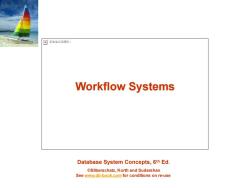
☒无法显示该图片。 Workflow Systems Database System Concepts,6th Ed. Silberschatz,Korth and Sudarshan See www.db-book.com for conditions on re-use
Database System Concepts, 6th Ed. ©Silberschatz, Korth and Sudarshan See www.db-book.com for conditions on re-use Workflow Systems
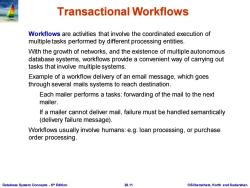
Transactional Workflows Workflows are activities that involve the coordinated execution of multiple tasks performed by different processing entities. With the growth of networks,and the existence of multiple autonomous database systems,workflows provide a convenient way of carrying out tasks that involve multiple systems. Example of a workflow delivery of an email message,which goes through several mails systems to reach destination. Each mailer performs a tasks:forwarding of the mail to the next mailer. If a mailer cannot deliver mail,failure must be handled semantically (delivery failure message). Workflows usually involve humans:e.g.loan processing,or purchase order processing. Database System Concepts-6th Edition 26.11 ©Silberschat乜,Korth and Sudarshan
Database System Concepts - 6 26.11 ©Silberschatz, Korth and Sudarshan th Edition Transactional Workflows Workflows are activities that involve the coordinated execution of multiple tasks performed by different processing entities. With the growth of networks, and the existence of multiple autonomous database systems, workflows provide a convenient way of carrying out tasks that involve multiple systems. Example of a workflow delivery of an email message, which goes through several mails systems to reach destination. Each mailer performs a tasks: forwarding of the mail to the next mailer. If a mailer cannot deliver mail, failure must be handled semantically (delivery failure message). Workflows usually involve humans: e.g. loan processing, or purchase order processing
按次数下载不扣除下载券;
注册用户24小时内重复下载只扣除一次;
顺序:VIP每日次数-->可用次数-->下载券;
- 《数据库系统概念 Database System Concepts》原书教学资源(第六版,PPT课件讲稿,英文版)Chapter 25 Advanced Data Types and New Applications.ppt
- 《数据库系统概念 Database System Concepts》原书教学资源(第六版,PPT课件讲稿,英文版)Chapter 24 Advanced Application Development.ppt
- 《数据库系统概念 Database System Concepts》原书教学资源(第六版,PPT课件讲稿,英文版)Chapter 23 XML.ppt
- 《数据库系统概念 Database System Concepts》原书教学资源(第六版,PPT课件讲稿,英文版)Chapter 22 Object-Based Databases.ppt
- 《数据库系统概念 Database System Concepts》原书教学资源(第六版,PPT课件讲稿,英文版)Chapter 21 Information Retrieval.ppt
- 《数据库系统概念 Database System Concepts》原书教学资源(第六版,PPT课件讲稿,英文版)Chapter 20 Data Analysis.ppt
- 《数据库系统概念 Database System Concepts》原书教学资源(第六版,PPT课件讲稿,英文版)Chapter 2 Introduction to the Relational Model.ppt
- 《数据库系统概念 Database System Concepts》原书教学资源(第六版,PPT课件讲稿,英文版)Chapter 19 Distributed Databases.ppt
- 《数据库系统概念 Database System Concepts》原书教学资源(第六版,PPT课件讲稿,英文版)Chapter 18 Parallel Databases.ppt
- 《数据库系统概念 Database System Concepts》原书教学资源(第六版,PPT课件讲稿,英文版)Chapter 17 Database System Architectures.ppt
- 《数据库系统概念 Database System Concepts》原书教学资源(第六版,PPT课件讲稿,英文版)Chapter 16 Recovery System.ppt
- 《数据库系统概念 Database System Concepts》原书教学资源(第六版,PPT课件讲稿,英文版)Chapter 15 Concurrency Control.ppt
- 《数据库系统概念 Database System Concepts》原书教学资源(第六版,PPT课件讲稿,英文版)Chapter 14 Transactions.ppt
- 《数据库系统概念 Database System Concepts》原书教学资源(第六版,PPT课件讲稿,英文版)Chapter 13 Query Optimization.ppt
- 《数据库系统概念 Database System Concepts》原书教学资源(第六版,PPT课件讲稿,英文版)Chapter 12 Query Processing.ppt
- 《数据库系统概念 Database System Concepts》原书教学资源(第六版,PPT课件讲稿,英文版)Chapter 11 Indexing and Hashing.ppt
- 《数据库系统概念 Database System Concepts》原书教学资源(第六版,PPT课件讲稿,英文版)Chapter 10 Storage and File Structure.ppt
- 《数据库系统概念 Database System Concepts》原书教学资源(第六版,PPT课件讲稿,英文版)Chapter 1 Introduction(Avi Silberschatz Henry F. Korth S. Sudarshan).ppt
- 电子科技大学:《大数据时代商业模式创新 Business model innovation》研究生课程教学资源(课件讲稿,杜义飞).pdf
- 电子科技大学:《大数据时代商业模式创新 Business model innovation》研究生课程教学资源(讲座)换一个视角看清商业本质.pdf
- 《数据库系统概念 Database System Concepts》原书教学资源(第六版,PPT课件讲稿,英文版)Chapter 3 Introduction to SQL.ppt
- 《数据库系统概念 Database System Concepts》原书教学资源(第六版,PPT课件讲稿,英文版)Chapter 4 Intermediate SQL.ppt
- 《数据库系统概念 Database System Concepts》原书教学资源(第六版,PPT课件讲稿,英文版)Chapter 5 Advanced SQL.ppt
- 《数据库系统概念 Database System Concepts》原书教学资源(第六版,PPT课件讲稿,英文版)Chapter 6 Formal Relational Query Languages.ppt
- 《数据库系统概念 Database System Concepts》原书教学资源(第六版,PPT课件讲稿,英文版)Chapter 7 Database Design - The Entity-Relationship Approach.ppt
- 《数据库系统概念 Database System Concepts》原书教学资源(第六版,PPT课件讲稿,英文版)Chapter 8 Relational Database Design.ppt
- 《数据库系统概念 Database System Concepts》原书教学资源(第六版,PPT课件讲稿,英文版)Chapter 9 Application Design and Development.ppt
- 《数据库系统概念 Database System Concepts》原书教学资源(第六版,附录,英文版)Advanced Relational Database Design.pdf
- 《数据库系统概念 Database System Concepts》原书教学资源(第六版,附录,英文版)Other Relational Query Languages.pdf
- 《数据库系统概念 Database System Concepts》原书教学资源(第六版,附录,英文版)Network Model.pdf
- 《数据库系统概念 Database System Concepts》原书教学资源(第六版,附录,英文版)Hierarchical Model.pdf
- 《数据库系统概念 Database System Concepts》原书教学资源(第五版,附录,英文版)Chapter A Network Model.ppt
- 《数据库系统概念 Database System Concepts》原书教学资源(第五版,附录,英文版)Chapter B Hierarchical Model.ppt
- 《数据库系统概念 Database System Concepts》原书教学资源(第五版,附录,英文版)Appendix C Advanced Relational Database Design.ppt
- 《数据库系统概念 Database System Concepts》原书教学资源(第五版,PPT课件讲稿,英文版)Chapter 1 Introduction(Avi Silberschatz Henry F. Korth S. Sudarshan).ppt
- 《数据库系统概念 Database System Concepts》原书教学资源(第五版,PPT课件讲稿,英文版)Chapter 10 XML.ppt
- 《数据库系统概念 Database System Concepts》原书教学资源(第五版,PPT课件讲稿,英文版)Chapter 11 Storage and File Structure.ppt
- 《数据库系统概念 Database System Concepts》原书教学资源(第五版,PPT课件讲稿,英文版)Chapter 12 Indexing and Hashing.ppt
- 《数据库系统概念 Database System Concepts》原书教学资源(第五版,PPT课件讲稿,英文版)Chapter 13 Query Processing.ppt
- 《数据库系统概念 Database System Concepts》原书教学资源(第五版,PPT课件讲稿,英文版)Chapter 14 Query Optimization.ppt
